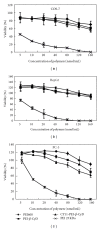FGF receptor-mediated gene delivery using ligands coupled to PEI-β-CyD
- PMID: 22570536
- PMCID: PMC3335427
- DOI: 10.1155/2012/989235
FGF receptor-mediated gene delivery using ligands coupled to PEI-β-CyD
Abstract
A novel vector with high gene delivery efficiency and special cell-targeting ability was developed using a good strategy that utilized low-molecular-weight polyethylenimine (PEI; molecular weight: 600 KDa [PEI600]) crosslinked to β-cyclodextrin (β-CyD) via a facile synthetic route. Fibroblast growth factor receptors (FGFRs) are highly expressed in a variety of human cancer cells and are potential targets for cancer therapy. In this paper, CY11 peptides, which have been proven to combine especially with FGFRs on cell membranes were coupled to PEI-β-CyD using N-succinimidyl-3-(2-pyridyldithio) propionate as a linker. The ratios of PEI600, β-CyD, and peptide were calculated based on proton integral values obtained from the (1)H-NMR spectra of the resulting products. Electron microscope observations showed that CY11-PEI-β-CyD can efficiently condense plasmid DNA (pDNA) into nanoparticles of about 200 nm, and MTT assays suggested the decreased toxicity of the polymer. Experiments on gene delivery efficiency in vitro showed that CY11-PEI-β-CyD/pDNA polyplexes had significantly greater transgene activities than PEI-β-CyD/pDNA in the COS-7 and HepG2 cells, which positively expressed FGFR, whereas no such effect was observed in the PC-3 cells, which negatively expressed FGFR. Our current research indicated that the synthesized nonviral vector shows improved gene delivery efficiency and targeting specificity in FGFR-positive cells.
Figures





References
-
- Li D, Yu H, Huang H, et al. FGF receptor-mediated gene delivery using ligands coupled to polyethylenimine. Journal of Biomaterials Applications. 2007;22(2):163–180. - PubMed
-
- Pack DW, Hoffman AS, Pun S, Stayton PS. Design and development of polymers for gene delivery. Nature Reviews Drug Discovery. 2005;4(7):581–593. - PubMed
-
- Lee M, Kim SW. Polyethylene glycol-conjugated copolymers for plasmid DNA delivery. Pharmaceutical Research. 2005;22(1):1–10. - PubMed
-
- Goyal R, Tripathi SK, Tyagi S, et al. Gellan gum blended PEI nanocomposites as gene delivery agents: evidences from in vitro and in vivo studies. European Journal of Pharmaceutics and Biopharmaceutics. 2011;79(1):3–14. - PubMed
-
- Swami A, Kurupati RK, Pathak A, Singh Y, Kumar P, Gupta KC. A unique and highly efficient non-viral DNA/siRNA delivery system based on PEI-bisepoxide nanoparticles. Biochemical and Biophysical Research Communications. 2007;362(4):835–841. - PubMed
MeSH terms
Substances
LinkOut - more resources
Full Text Sources

